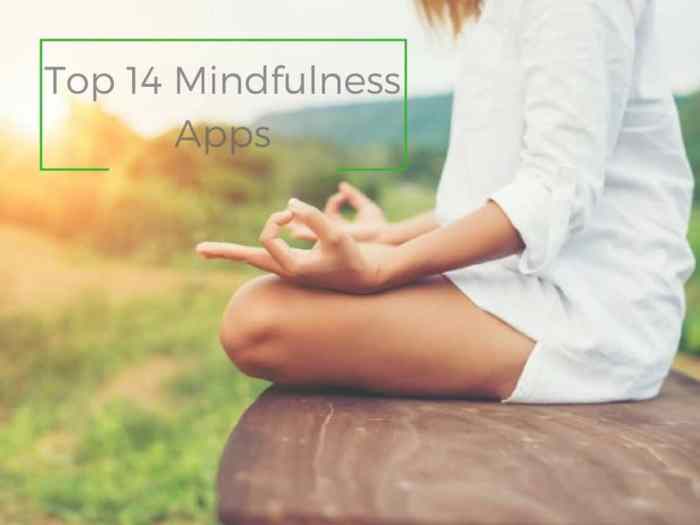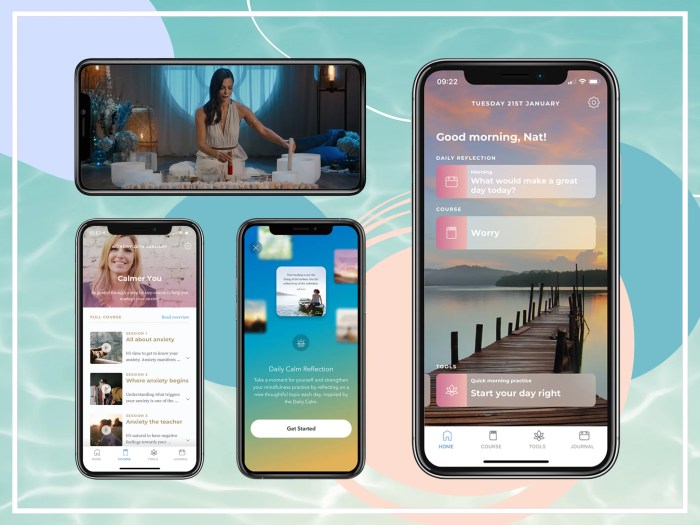Mindfulness Apps: A Guide to Finding Inner Peace

Mindfulness apps have become a popular tool for navigating the stresses of modern life. These digital companions offer a variety of techniques to cultivate mindfulness, from guided meditations to breathing exercises, all designed to help users find inner peace and improve their well-being.
The growing popularity of mindfulness apps can be attributed to several factors, including the increasing awareness of mental health issues, the accessibility of technology, and the desire for self-care. These apps provide a convenient and personalized way to practice mindfulness, offering a range of techniques tailored to individual needs and preferences.
The Rise of Mindfulness Apps

The use of mindfulness apps has exploded in recent years, becoming an integral part of many people’s wellness routines. These apps offer guided meditations, breathing exercises, and other mindfulness techniques designed to reduce stress, improve focus, and promote overall well-being.
Popularity and Growth
The popularity of mindfulness apps is evident in their widespread adoption and impressive download numbers. According to a 2023 report by Statista, the global mindfulness app market is expected to reach \$3.8 billion by 2028. This growth is fueled by several factors, including increasing awareness of mental health issues and the desire for accessible and convenient tools for self-care.
Factors Contributing to the Rise
- Increased Stress Levels: Modern life is characterized by a constant barrage of demands and pressures, leading to heightened stress levels. Mindfulness apps offer a readily available and effective way to manage stress and promote relaxation.
- Growing Awareness of Mental Health: There is a growing understanding of the importance of mental health and well-being. Mindfulness apps are seen as a valuable tool for improving mental health and promoting emotional resilience.
- Accessibility and Convenience: Mindfulness apps are easily accessible through smartphones and other devices, making it convenient for individuals to engage in mindfulness practices anytime and anywhere.
- Personalized Experiences: Many apps offer personalized programs and features, allowing users to tailor their mindfulness practice to their specific needs and preferences.
Types of Mindfulness Apps
Mindfulness apps have become increasingly popular in recent years, offering a wide range of tools and techniques to cultivate mindfulness and improve mental well-being. These apps cater to various needs and preferences, encompassing diverse approaches to mindfulness practice.
Types of Mindfulness Apps
Mindfulness apps can be categorized based on their primary focus, offering specialized tools and techniques to address specific needs and goals. Here are some common categories:
| App Name | Category | Key Features | Target Audience |
|---|---|---|---|
| Headspace | Meditation | Guided meditations for beginners and experienced practitioners, sleep meditations, and courses on various topics like stress, anxiety, and focus. | Individuals seeking to learn and practice meditation, reduce stress, improve sleep, and enhance focus. |
| Calm | Meditation, Sleep Improvement | Guided meditations, sleep stories, nature sounds, breathing exercises, and music for relaxation. | Individuals seeking to reduce stress, improve sleep quality, and promote relaxation. |
| Insight Timer | Meditation, Breathing Exercises | A vast library of guided meditations, a timer for silent meditation, community features, and access to teachers and courses. | Individuals seeking a wide variety of meditation practices, including silent meditation, guided meditations, and access to a global community. |
| Smiling Mind | Meditation, Stress Management | Guided meditations specifically designed for children and adolescents, focusing on emotional regulation, stress management, and mindfulness skills. | Children and adolescents seek to develop mindfulness skills, manage stress, and improve emotional well-being. |
| Waking Up | Meditation, Philosophy | Guided meditations based on Buddhist teachings, teachings on mindfulness and meditation, and discussions on ethical and philosophical topics. | Individuals interested in exploring the philosophical underpinnings of mindfulness and meditation, particularly those with a Buddhist background. |
Features and Functionality
Mindfulness apps offer a diverse range of features designed to enhance the user’s mindfulness practice. These features cater to various needs and preferences, making mindfulness accessible and engaging for a wide audience.
Common Features of Mindfulness Apps
- Guided Meditations: Guided meditations are a cornerstone of many mindfulness apps. These sessions typically involve an instructor’s voice guiding users through a series of breathing exercises, visualizations, or body scans. They provide structure and support, particularly for beginners, helping them to cultivate a focused and present state of mind.
- Timer Settings: Mindfulness apps often include timer settings that allow users to customize the duration of their meditation sessions. This feature helps set realistic goals and gradually increase the length of practice over time. It also provides a structured framework for maintaining consistency and establishing a regular mindfulness routine.
- Progress Tracking: Many mindfulness apps track user progress, providing insights into their practice habits. This feature can motivate users by highlighting their accomplishments and identifying areas for improvement. It also allows users to monitor their progress over time, fostering a sense of accomplishment and encouraging continued engagement.
- Personalized Recommendations: Some mindfulness apps offer personalized recommendations based on user preferences and practice history. This feature can help users discover new meditation techniques, themes, or instructors that align with their interests and needs. It also helps to tailor the app experience, making it more relevant and engaging for individual users.
- Integration with Other Devices: Several mindfulness apps integrate with other devices, such as smartwatches or fitness trackers. This integration allows users to track their meditation sessions alongside other health data, providing a more holistic view of their well-being. It also enables users to receive reminders or notifications for their mindfulness practice, promoting consistency and adherence to their routine.
Benefits of Common Features
| Feature | Description | Benefits |
|---|---|---|
| Guided Meditations | Sessions with an instructor’s voice guiding users through breathing exercises, visualizations, or body scans. | Provides structure and support for beginners, and helps cultivate focus and a present state of mind. |
| Timer Settings | Allows users to customize the duration of meditation sessions. | Helps set realistic goals, increases practice length gradually, maintains consistency, and establishes a routine. |
| Progress Tracking | Tracks user progress, providing insights into practice habits. | Motivates users by highlighting accomplishments, identifies areas for improvement, monitors progress over time, fosters a sense of accomplishment, and encourages continued engagement. |
| Personalized Recommendations | Offers recommendations based on user preferences and practice history. | Helps discover new meditation techniques, themes, or instructors, and tailors the app experience, making it more relevant and engaging. |
| Integration with Other Devices | Integrates with smartwatches or fitness trackers. | Tracks meditation sessions alongside other health data provide a holistic view of well-being, enables reminders or notifications for mindfulness practice, and promotes consistency and adherence to routine. |
Benefits of Using Mindfulness Apps

Mindfulness apps offer a convenient and accessible way to cultivate mindfulness practices in daily life. These apps provide guided meditations, breathing exercises, and other tools to help users develop greater awareness, focus, and emotional regulation. Numerous studies and anecdotal evidence suggest that regular use of mindfulness apps can lead to significant improvements in various aspects of well-being.
Reduced Stress and Anxiety
Mindfulness-based stress reduction techniques are effective in reducing stress and anxiety levels. By focusing on the present moment, mindfulness practices help to interrupt the cycle of negative thoughts and emotions that contribute to stress.
- A study published in the Journal of the American Medical Association found that mindfulness-based stress reduction (MBSR) was effective in reducing stress, anxiety, and depression in individuals with chronic pain.
- Another study, published in the journal Mindfulness, found that using a mindfulness app for 15 minutes a day for two weeks led to significant reductions in stress and anxiety levels.
Improved Focus and Concentration
Mindfulness practices involve training the mind to focus on the present moment without judgment. This can enhance attention span and improve concentration abilities.
- Research suggests that mindfulness meditation can improve working memory and cognitive flexibility, which are essential for focus and concentration.
- Studies have also shown that mindfulness training can help individuals with attention-deficit/hyperactivity disorder (ADHD) improve their focus and concentration.
Enhanced Emotional Regulation
Mindfulness practices help individuals become more aware of their emotions and develop greater control over their emotional responses. By observing emotions without judgment, users can learn to manage difficult emotions more effectively.
- A study published in the journal Emotion found that mindfulness training can help individuals regulate their emotions more effectively, leading to improved mood and well-being.
- Another study, published in the journal Clinical Psychology Review, found that mindfulness-based interventions were effective in reducing symptoms of anxiety, depression, and anger.
Improved Sleep Quality
Mindfulness practices, such as guided meditations and breathing exercises, can promote relaxation and reduce stress, which can lead to improved sleep quality.
- Research suggests that mindfulness meditation can reduce insomnia symptoms and improve sleep quality.
- A study published in the journal Sleep Medicine found that mindfulness-based interventions were effective in reducing sleep disturbances and improving sleep quality in individuals with insomnia.
Increased Self-Awareness
Mindfulness practices encourage individuals to pay attention to their thoughts, feelings, and bodily sensations without judgment. This increased self-awareness can lead to a deeper understanding of oneself and one’s motivations.
- By practicing mindfulness, individuals can become more aware of their patterns of thinking and behavior, which can help them make healthier choices.
- Increased self-awareness can also lead to greater compassion and acceptance of oneself and others.
Table of Benefits and Supporting Evidence
| Benefit | Explanation | Supporting Evidence |
|---|---|---|
| Reduced Stress and Anxiety | Mindfulness practices help interrupt the cycle of negative thoughts and emotions that contribute to stress. | A study published in the Journal of the American Medical Association found that MBSR was effective in reducing stress, anxiety, and depression in individuals with chronic pain. |
| Improved Focus and Concentration | Mindfulness training can enhance attention span and improve concentration abilities. | Research suggests that mindfulness meditation can improve working memory and cognitive flexibility, which are essential for focus and concentration. |
| Enhanced Emotional Regulation | Mindfulness practices help individuals become more aware of their emotions and develop greater control over their emotional responses. | A study published in the journal Emotion found that mindfulness training can help individuals regulate their emotions more effectively, leading to improved mood and well-being. |
| Improved Sleep Quality | Mindfulness practices, such as guided meditations and breathing exercises, can promote relaxation and reduce stress, which can lead to improved sleep quality. | Research suggests that mindfulness meditation can reduce insomnia symptoms and improve sleep quality. |
| Increased Self-Awareness | Mindfulness practices encourage individuals to pay attention to their thoughts, feelings, and bodily sensations without judgment. | By practicing mindfulness, individuals can become more aware of their patterns of thinking and behavior, which can help them make healthier choices. |
Choosing the Right Mindfulness App

With a plethora of mindfulness apps available, choosing the right one can feel overwhelming. The ideal app for you will depend on your individual needs and preferences. Here are some key factors to consider:
App Features
The features of a mindfulness app are crucial to consider. They can range from basic guided meditations to more advanced features like sleep tracking and journaling. Some features to look for include:
- Guided Meditations: These sessions provide instructions and prompts to guide you through different mindfulness techniques. Look for apps that offer a variety of guided meditations, covering topics like stress reduction, anxiety management, sleep, and gratitude.
- Mindfulness Exercises: Some apps offer exercises beyond meditation, such as breathing techniques, body scans, and gratitude practices. These can provide a more holistic approach to mindfulness.
- Music and Soundscapes: Music and nature sounds can enhance the meditative experience. Look for apps that offer a wide selection of music and soundscapes to choose from.
- Progress Tracking: Tracking your progress can help you stay motivated and see how your mindfulness practice is affecting your well-being. Look for apps that allow you to track your meditation sessions, progress, and insights.
- Personalized Recommendations: Some apps use algorithms to recommend meditations and exercises based on your needs and preferences.
- Community Features: Some apps offer community features, allowing you to connect with others on their mindfulness journey. This can provide support and motivation.
User Interface
A user-friendly interface is essential for a positive mindfulness experience. The app should be easy to navigate, visually appealing, and intuitive. Consider the following:
- Ease of Use: The app should be easy to understand and navigate, even for beginners. Look for apps with clear instructions and a simple layout.
- Visual Appeal: A visually appealing interface can enhance the overall experience. Look for apps with calming colors, soothing graphics, and a pleasant design.
- Intuitive Navigation: The app should be easy to navigate, with clear menus and options. You should be able to find the features you need quickly and easily.
Cost
Mindfulness apps come in various price ranges, from free to premium subscriptions. Consider your budget and the features offered by each app.
- Free Apps: Many mindfulness apps offer basic features for free, including guided meditations and timer functions. However, free apps may have limited features or include ads.
- Paid Apps: Paid apps typically offer more features, such as a wider selection of meditations, personalized recommendations, and progress tracking. They may also have a more user-friendly interface and fewer ads.
- Subscription Models: Some apps use a subscription model, charging a monthly or annual fee for access to all features. This can be a good option if you value the app’s features and are committed to regular mindfulness practice.
User Reviews
Reading user reviews can provide valuable insights into the app’s effectiveness, user experience, and any potential issues. Look for reviews that discuss the app’s features, user interface, and overall value.
- App Store and Google Play Store: Read user reviews on app stores like the Apple App Store and Google Play Store. These reviews often provide insights into the app’s usability and effectiveness.
- Mindfulness App Reviews: Several websites and blogs offer reviews of mindfulness apps. These reviews can provide more detailed information about the app’s features and benefits.
The Future of Mindfulness Apps
The mindfulness app market is rapidly evolving, driven by increasing awareness of mental health and the accessibility of technology. As the demand for mindfulness tools grows, developers are constantly innovating, introducing new features and functionalities that enhance the user experience and personalize the practice.
This section explores the potential trends and innovations shaping the future of mindfulness apps.
Integration with Wearable Technology
Wearable technology is poised to play a significant role in the future of mindfulness apps. Smartwatches and fitness trackers can monitor physiological data like heart rate, sleep patterns, and activity levels. This data can be integrated into mindfulness apps to provide personalized insights and recommendations.
For example, an app could analyze heart rate variability and suggest breathing exercises based on stress levels.
Artificial Intelligence and Personalized Mindfulness
Artificial intelligence (AI) is revolutionizing various industries, and mindfulness apps are no exception. AI algorithms can analyze user data, including their preferences, habits, and progress, to create personalized mindfulness experiences. This could involve:
- Tailoring meditation sessions to individual needs and goals.
- Providing personalized feedback and encouragement.
- Suggesting relevant content and resources.
Augmented Reality and Virtual Reality Experiences, Mindfulness apps
Augmented reality (AR) and virtual reality (VR) technologies are opening new possibilities for immersive mindfulness experiences. AR can overlay digital elements onto the real world, creating interactive visualizations for guided meditations. VR can transport users to serene virtual environments, enhancing their sense of presence and immersion.
Gamification and Interactive Mindfulness
Gamification is increasingly being used to make mindfulness more engaging and accessible. This involves incorporating game mechanics, such as points, rewards, and challenges, into mindfulness apps. Gamification can motivate users to stick to their practice and track their progress.
Community and Social Features
Social features are becoming increasingly important in mindfulness apps. Users can connect with others who share similar goals and support each other on their mindfulness journey. This can foster a sense of community and accountability, enhancing the overall experience.
Integration with Other Health and Wellness Apps
Mindfulness apps are increasingly being integrated with other health and wellness apps, such as sleep trackers, fitness apps, and nutrition apps. This integration provides a holistic view of well-being and allows users to track their progress across different aspects of their health.
Focus on Mental Health Conditions
There is a growing focus on developing mindfulness apps specifically for mental health conditions, such as anxiety, depression, and insomnia. These apps often incorporate evidence-based techniques and are designed to work alongside traditional therapies.
Enhanced Accessibility and Affordability
Mindfulness apps are becoming more accessible and affordable. Many apps offer free versions with basic features, while premium versions offer more advanced functionalities. The increasing availability of free or low-cost mindfulness apps makes it easier for everyone to benefit from the practice.
Closing Summary
As technology continues to evolve, mindfulness apps are likely to become even more sophisticated, incorporating features like personalized recommendations, virtual reality experiences, and even AI-powered guidance. The future of mindfulness apps is bright, offering the potential to make mindfulness practices more accessible and engaging for a wider audience.
Ultimately, these apps empower individuals to take control of their mental well-being, fostering a sense of calm and clarity in an increasingly chaotic world.
Comments are closed.